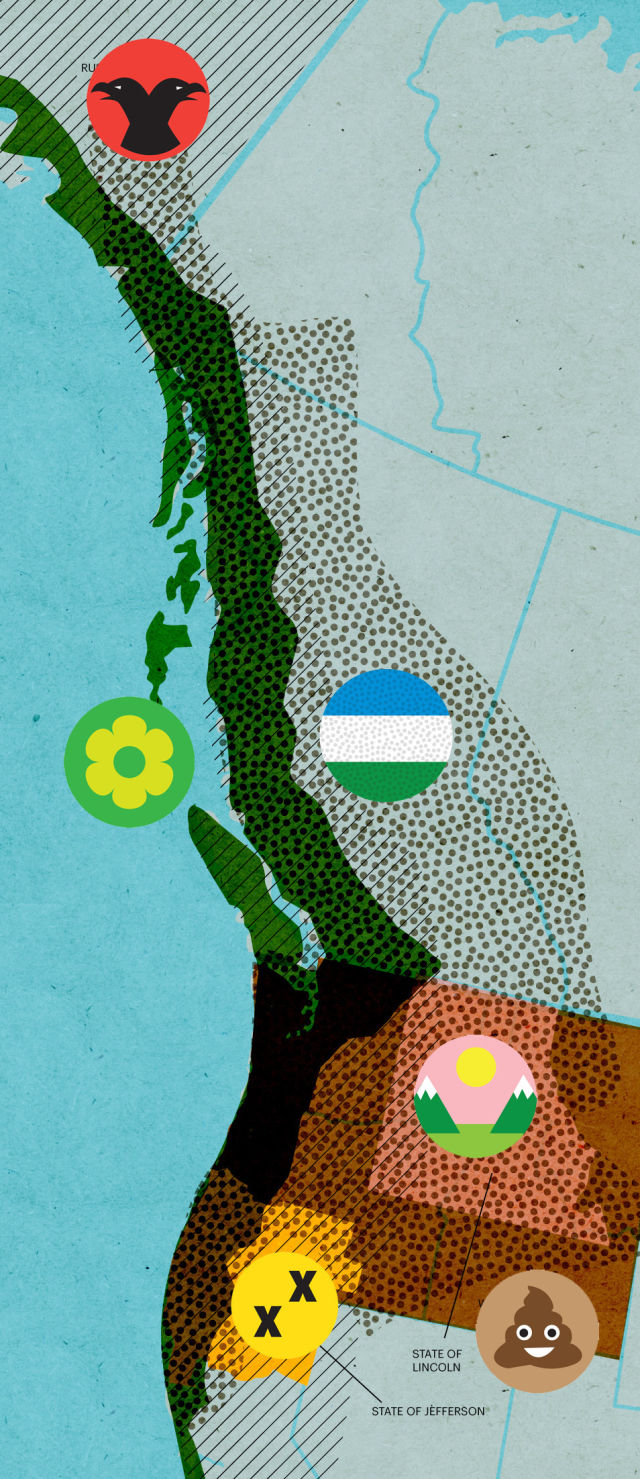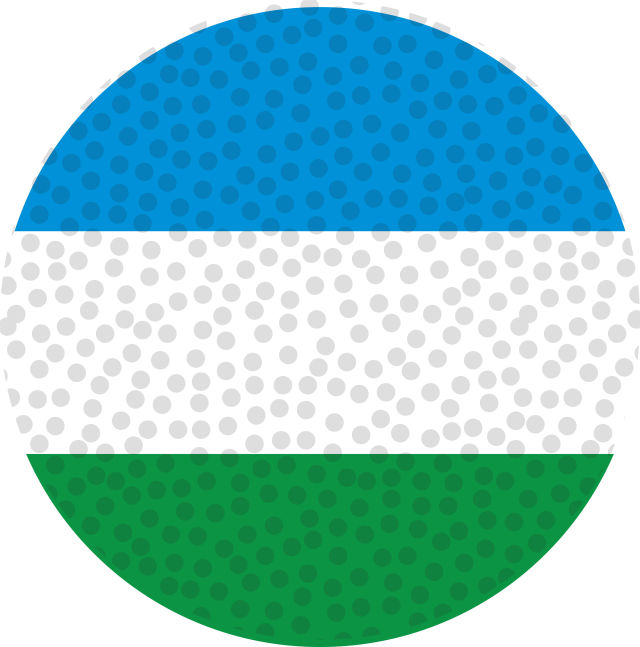The Northwest Has Always Fantasized about Starting Its Own Country

Image: Amy Martin
Every Oregonian will say it: we’re special. How special? Special enough to have our own country. Throughout the Northwest’s history, people have harbored strange visions of breakaway states. These imaginary nations may be disconnected from political reality, but their persistence speaks to something in our regional soul.
“We as Americans, and particularly westerners, I believe, have a romantic fixation on our individuality,” says Peter Laufer, a professor of journalism at the University of Oregon and author of The Elusive State of Jefferson. “That morphs into a regionalism that can be quaint or perverse.” Here, a short guide to Oregon’s phantom realms.
CASCADIA

Image: Amy Martin
Population: 15 million
Exports: Tech, beer, soccer
Government: Uh, consensus-based metarepublic?
Our best-known fantasy nation, which dates, more or less, to the 1980s, is many things. A proposed state made up of Oregon, Washington, and British Columbia, with a capital in Seattle. (Not happening.) A “bioregion” defined by culture and environment and encompassing all of the Northwest and parts of Montana. A fierce soccer rivalry between Portland, Seattle, and Vancouver. A blue, white, and green flag proudly plastered over T-shirts, keychains, and microbrew labels. A regional identity. A brand. It’s just a feeling, man.
From Hunter Shobe, associate professor of geography at Portland State: “When people think about Cascadia they break free from the normal ways we think about places, whether that’s city, state, or national boundaries. It allows people to use their geographic imagination. Do we have more in common with people in Seattle or with people in Eastern Oregon?”
THE STATE OF LINCOLN

Image: Amy Martin
Population: 2 million
Exports: Unknown
Government: Plain old US statehood
The Cascade Mountain range bisects Oregon and Washington in a culturally awkward way: on one side you have rain-soaked urbanites; on the other, dusty cowboys. What gives? First proposed in 1907, Lincoln would divide the region in a more logical way (geographically, at least), mashing together the sagebrush-strewn wildlands east of the range: Eastern Oregon and Washington, Northern Idaho, and Western Montana. No longer will the hardy folk out in Pendleton and Burns be yoked to us dandies in Portland!
ECOTOPIA

Image: Amy Martin
Population: 14 million (declining year over year)
Exports: None
Government: Female-dominated, decentralized democracy
In the 1975 novel Ecotopia, Ernest Callenbach imagined a reporter, Will Weston, as the first American to venture into this land since its secession 20 years before. Spanning a thin sliver west of the coastal ranges, from central California stretching far into the north, Ecotopia is primarily inhabited (and governed) by women. Ecotopians live in giant wooden tubes, glued together to form bulbous apartment buildings. Night skies loom dark and eerily silent, while a high-speed train network ferries people between car-free cities at 360 kilometers per hour. (Ecotopians use the metric system, natch.) Marijuana is legal. So is heroin. Nonmonogamy and homosexuality are common in a land of radical environmentalism deeply influenced by Native American cultures. But not all of Ecotopia is so groovy: its black population is almost entirely segregated in an autonomous enclave called Soul City. Yikes.
From the novel: “The Ecotopians are almost Dickensian: often strange enough, but not crazy-looking or sordid, as the hippies of the sixties were. Fanciful hats and hairdos, jackets, vests, leggings, tights; so help me, I think I even saw a codpiece.”
THE STATE OF JEFFERSON

Image: Amy Martin
Population: 2.3 million
Exports: Copper
Government: Plain old US statehood
In the fall of 1941, a group of men blocked traffic on US 99 near Yreka, California, and issued a Proclamation of Independence for “the greatest copper belt in the Far West.” It read, “Until California and Oregon build a road into copper country, Jefferson, as a defense-minded State, will be forced to rebel each Thursday and act as a separate State.” The idea: that Sacramento and Salem don’t care about the region straddling the Oregon-California border, so it should go its own way. Pearl Harbor brought an end to the Jeffersonians’ insurrectionary antics, but the cause lives on as an expression of Southern Oregon pride, and a flag depicting the state’s notional seal: a mining pan with two X’s to signify the dual abandonment.
Peter Laufer: “They either don’t do the math or they ignore the math, and don’t realize ... that the region isn’t self-sufficient. [The idea] manages to appeal to just about anybody that’s got some problem with something: from marijuana growers to white supremacists, from antifederal government types to purist back-to-the-landers.”
THE WHITE HOMELAND

Image: Amy Martin
Population: 9 million, all miserable
Exports: Hatred
Government: Fascist dictatorship
Not all utopias dreamed up are, er, utopian. The Northwest Front, a white separatist group inspired by an Idaho pastor named Richard Butler, who died in 2004, outlines the establishment of a “white homeland” comprising parts of Idaho, Montana, Washington, and Oregon. The plan is divided into four phases: relocating white supremacists to the Northwest, organizing them as a military force, declaring political independence, and then finally setting up the homeland as soon as the United States collapses. By their own admission, the racists are still struggling to figure out how to get started on Phase 1.
From the plan: “Nine million White people is a lot of people, but with hard propaganda work by an active and fanatically dedicated minority, enough of them can be convinced to join us to provide local bases for incoming settlement.... The only alternative is the present status quo, sitting at our computers pecking on keyboards and once in a blue moon wandering out in public holding a sign and letting ourselves be pelted with garbage....”
RUSSIAN AMERICA

Image: Amy Martin
Population: 167 million (including the rest of the Russian Federation, or maybe Empire)
Exports: Refuseniks, artisanal vodka, morose literature
Government: Constitutional republic, ostensibly, but with more czar-iness
Not so much a utopia as an alternate reality. In the 19th century, Russia’s empire extended over most of Alaska, and the Motherland claimed a sizable chunk of the Pacific Northwest all the way into northern California. Not wanting to defend their claim militarily, the Russians sold Alaska to the United States for 2 cents an acre in 1867. Ponder, comrades, what would have happened if Russia had stayed to keep the valuable fur trade.
From Nikolai Rezanov, who founded the Russian-American Company in 1799, on enticing Russian colonists to stay in the New World: “Everything is dead now, but with the introduction of monetary circulation the whole region will be alive. All artisans and port workers should remain permanently in their places.... In time they will build houses. Having their own property and amassing it they will find so much pleasure in settled life that they will lose the desire to leave it.”



